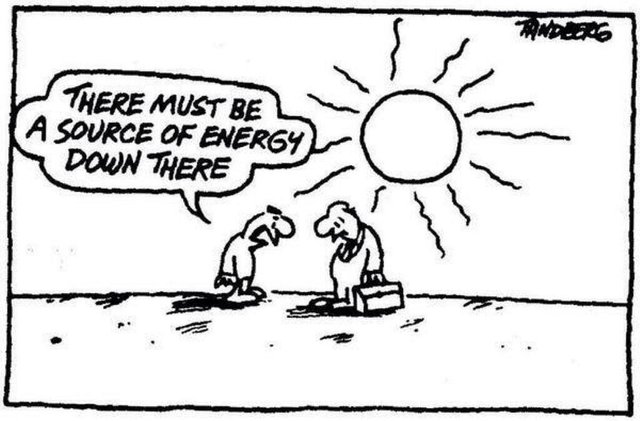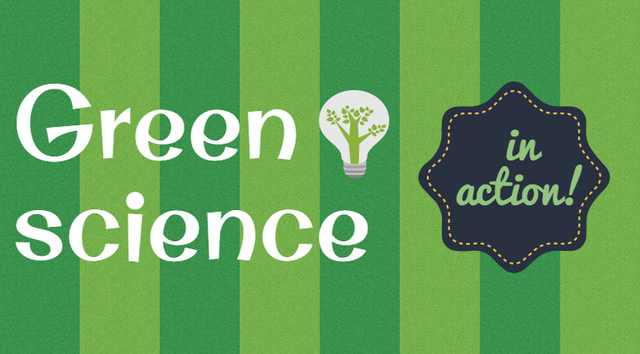Ciencia verde en acción #3: ¿Cómo es posible transformar la energía del sol? ☀ | Green Science in action #3: How is it possible to transform the sun energy? ☀

Las publicaciones de Ciencia verde en acción tienen como objetivo exponer brevemente qué está sucediendo en el mundo respecto al desarrollo de la industria y su impacto a la sociedad desde el punto de vista ambiental, teniendo en cuenta qué alternativas se están planteando para que no sólo se logre tener una producción económica sólida, sino también y sobre todo se tenga un compromiso con la protección y conservación del medio ambiente.
Te invito a leer los anteriores posts:
Ciencia verde en acción 1: Bioetanol: En realidad no muy "bio"
Ciencia verde en acción 2: Nanocompuestos: Materiales prometedores para empaques alimenticios
El desarrollo de los páneles solares no es algo nuevo; la primera célula solar fue construida a finales del siglo XIX por Charles Fritts. Sin embargo, sólo a partir de los últimos años se han realizado investigaciones y proyectos que le dan relevancia y hacen realidad la implementación de la tecnología de páneles fotovoltáicos y colectores solares para el aprovechamiento de la energía del sol. De esta forma se está cada vez más cerca de un mercado energético en el que la producción de energía basada en combustibles fósiles, los cuales bien sabemos son contaminantes y no renovables, se deja atrás.
Como ya se mencionó, hay dos formas de utilizar la energía del sol: para producir energía eléctrica o para producir energía calorífica. En este post quiero contarles de una forma no muy técnica cómo funcionan exactamente los páneles solares fotovoltáicos y los colectores, los cuales pueden ver en mi anterior post en el que muestro el bellísimo Barrio Solar Schlierberg de Freiburg, Alemania.
Páneles solares fotovoltáicos
La siguiente es la representación sencilla de lo que es una celda fotovoltáica. No en todos los casos se utiliza Silicio como semiconductor, sin embargo es el más utilizado en general por ser de fácil acceso y representar un rendimiento en la transformación de energía solar a eléctrica.

Fuente
Ahora, como la imagen de arriba es un poco aburrida, intentaré explicar de otra forma: Imaginen un sandwich sin relleno cuyo pan es de Silicio. Aunque sin relleno, ambas tajadas de pan tienen diferente sabor; la tajada de Silicio que da al sol (capa n) debe tener incrustaciones de un material cuyos átomos tengan más electrones que el silicio (como el fósforo) y de igual forma la otra capa (capa p), de un material cuyos átomos posean menos electrones que el silicio (como el oro o boro), de forma que cuando los fotones irradien a la capa n rompan enlaces y obliguen a los electrones a moverse a la capa p, permitiendo así un flujo de corriente eléctrica.

Colectores solares térmicos
Los colectores solares son un poco más fáciles de entender. Lo que se busca al instalarlos es que el calor del sol se concentre en los tubos por donde pasa el agua a la que se requiere aumentar la temperatura. Hay colectores solares de polietileno, que usualmente se utilizan para climatizar piscinas, planos y de tubos de vacío, siendo estos últimos más eficientes debido a que, al estar los tubos aislados al vacío, no hay pérdidas de calor por conducción (el calor se pierde al transferirse con el ambiente), cosa que si sucede en los planos.

Ejemplo de tubo de vacío (Fuente)

Como ven en la imagen anterior, los colectores solares, al igual que los páneles fotovoltáicos deben ser instalados a una inclinación específica, según el lugar en donde van a instalarse, de forma que sea posible aprovechar la mayor cantidad de radiación solar.
¡Gracias por leerme! 🌳❤

Sí, ¡en sus narices! (Fuente)


Green science in action posts aim to expose briefly what is happening in the world regarding the development of the industry and its impact on society from the environmental point of view, contemplating what alternatives are being considered so that not only It is achieved having a solid economic production, but also and above all a commitment to the protection and conservation of the environment.
If you missed earlier posts:
Green science in action 1: Bioethanol: actually not so “bio”
Green science in action 2: Nanocomposites: promising materials for food packaging
The development of solar panels is not something new; The first solar cell was built at the end of the 19th century by Charles Fritts. However, only since the last years have been done researches and projects that give relevance and make the implementation of the technology of photovoltaic panels and solar collectors for the use of the energy of the sun a true. In this way, we are getting closer to an energy market where the production of energy based on fossil fuels, which we well know are polluting and non-renewable, is left behind.
As already mentioned, there are two ways of using the energy of the sun: to produce electrical energy or to produce heat energy. In this post I want to tell you in a little technical way how exactly the photovoltaic solar panels and heat collectors work, both things you can see them in my previous post in which I show the beautiful Solar Neighborhood Schlierberg of Freiburg, Germany.
Solar photovoltaic panels
The following is the simple representation of what is a photovoltaic cell. Silicon is not used in all cases as a semiconductor, however it is most commonly used because it is easily accessible and represents a better performance in the transformation from solar to electric energy.

Source
Now, as the picture above is a little boring, I'll try to explain it another way: Imagine a sandwich without stuffing whose bread is Silicon. Although without filling, both slices of bread have different flavor; The silicon slice that is faced to the sun (n-part) must have inlays of a material whose atoms have more electrons than silicon (like phosphorus) and likewise the other layer (p-part) of a material whose atoms have less Electrons than silicon (such as gold or boron), so that when photons radiate to the n-part break bonds and force the electrons to move to p-part, thus allowing an electric current flow.

Solar thermal collectors
Solar thermal collectors are a little easier to understand. What is wanted when installing them is that the heat of the sun is concentrated in the tubes through which passes the water that is required to have a higher temperature. There are solar collectors of polyethylene, which are usually used to heat swimming pools, flat tubes and vacuum tubes, which are more efficient than the flat ones; as the tubes are insulated under vacuum, there is no heat loss through conduction (heat is lost when transferring to the outside environment), something that does happen in the flat tubes.

Example of vacuum tube (Source)

As you can see in the previous image, solar heat collectors, like the photovoltaic panels, must be installed at a specific inclination, according to the place where they are going to be installed, that way is possible to take advantage of the greatest amount of solar radiation.
Thank you for reading me! 🌳❤

Yes, Right in front of you! (Source)

Congratulations @valenttina! You have completed some achievement on Steemit and have been rewarded with new badge(s) :
Click on any badge to view your own Board of Honor on SteemitBoard.
For more information about SteemitBoard, click here
If you no longer want to receive notifications, reply to this comment with the word
STOPMuy interesante tu post. Me gusto mucho. Creo que las energías renovables son el futuro y ya muchos países están apostando a ellas. Gracias por compartir.
Gracias a ti por comentar! :)